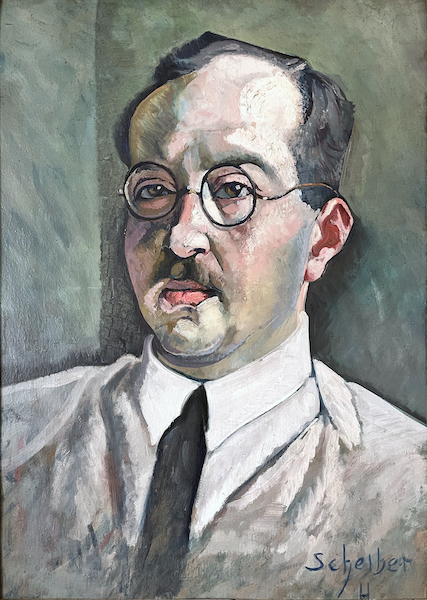Biography
Hugó Scheiber is a popular representative of modern Hungarian painting, he was a largely self-taught and instinctive talent. He was born in 1873 in Budapest. At the age of eight, he and his family moved from Budapest to Vienna. His father worked as the title painter of the Prater, and he learned the basics of painting from him. In 1898, they returned to Budapest, he worked and studied as a locksmith. Between 1898 and 1900, he trained at the College of Applied Arts, which he did not graduate from.
He was a soldier in the First World War. Until 1914, he painted landscapes and still lifes as well as portraits, often in oil, showing the influence of Impressionism and plein air. In the 1910s, his style was influenced by German expressionism, thus he developed his new stylized world of colors and shapes.
Visiting Budapest in the 1920s, Herwarth Walden, the founder of the Der Sturm gallery and art magazine, immediately recognized his talent and invited him to Berlin. In the beginning, he supported Scheiber financially and presented Scheiber's works over the years. In 1921, he organized his first exhibition in the Berlin gallery together with his friend Béla Kádár. After 1924, until the end of the decade, he could present himself with a collection exhibition at least once every year, for example in the first year with László Moholy-Nagy, and in 1928 with Kurt Schwitters. Walden often published reproductions of Scheiber's works in his art magazine, which has the same name as the gallery and is at least as important.
He was an extremely prolific, fast-working artist. Most of his works are made on paper and cardboard. His oeuvre consists of thousands of works. Many of his works are still hidden, but he still has more than a thousand known works.
His drawings and paintings were noticed in England and America: he had exhibitions in London and New York, in the latter city he participated in the Brooklyn Museum's Modern Art exhibition in 1926, which played a significant role in the presentation of European isms in America. In 1930, he organized an exhibition in Vienna.
At the invitation of Filippo Tommaso Marinetti, who was staying in Budapest, he also participated in the Roman exhibition of the Futurists in 1933. In his opening speech, Marinetti called him one of the most important contemporary painters. In a significant part of his works, he captures the essence of modern, metropolitan life.
He struggled with constant existential problems, so he often sold his pictures for pennies or even a lunch. He survived the Holocaust in the Budapest ghetto, his health was shaken. His difficult fate was compounded by the fact that in 1949 the Association of Fine Artists refused to accept him as one of its members. He died in oblivion in 1950. His grave is located in the Jewish cemetery on Kozma Street.

